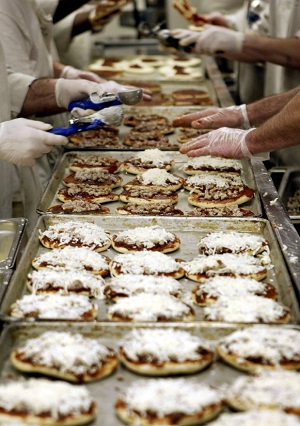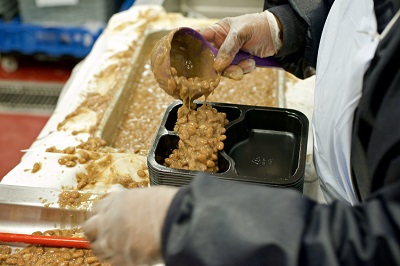
Many people wonder how prison meals taste like and who prepares them. Most people think that meals served in jail taste awful and that all prisoners eat the same kind of food but truth is, meals are prepared in accordance to state laws and prison house rules.
Another factor that affects what prisoners eat is their religion, medical conditions, and in some cases even their age. Older inmates may be required to have more nutritious food. They may not be served with foods that are high in sugar and cholesterol. Inmates with medical conditions may also request for special dishes that they need to eat to stay healthy.
Prison food may be cooked by caterers or food companies contracted by the state prison or the government. Some jails let groups of prisoners prepare the meals. They may have certain agreements that give them the option to let prisoners cook the breakfast, lunch and dinners for all the prisoners in their facility.
They may also have a store from which inmates can purchase food. Candies, chocolates, chips and sandwiches may be available. Some prisoners who have the financial capability to purchase from these stores prefer not to eat the food served to them. Some of them find the food very poorly cooked, while some find it pretty much the same as what they eat outside of prison.
There are several factors that affect the taste at type of food served in jails. The budget is the number one factor that affects how and what type of food is served. The budget normally depends on the number of prisoners and the budget allocated for their food.
The state prisons respect individual concerns which may include those religious or ethnic in nature.
Food in jails may not be as delicious as the food outside prison but there are state and federal laws that require the food to be safe, clean and healthy. Carefully planned prison meals may not be as tasty as food served at their homes but they are generally healthy. The laws require that the food be low in sugar and salt, as low fat as possible, with just enough carbohydrates and full of minerals and nutrients.
Fruits and vegetables are usually served to make sure they still get the right kind of nutrition. Planned meals are normally created every week or bi monthly. Prisons with more inmates may plan meals on a monthly basis. Some jails even get survey from inmates as to what food they want served for breakfast, lunch and dinner but most jails follow food lists from dietitians or health organizations that are contracted by the government.
These prison meals include fruits and vegetables, which probably taste the same as fruits and vegetables served elsewhere. Vegetables are normally steamed or stir-fried. Each prisoner gets a cup or half a cup per meal. Salt and pepper may be added if a prisoner prefers a little more salty food.
Condiments are commonly available at the dining place. These include Catsup, salt, pepper, sugar and chili.
But as to how they taste like? Well, it may not be as good as you think.

According to Inmate Classified, a prison magazine, it really does not matter what is on the menu. It seems as if a groundhog has been methodically chipped into pieces and dipped into soya—and has been turned into meatballs. Some say that they wouldn’t even feed it to their dogs, given the chance—so just imagine how that tastes like!
Bread could even be a day old, or dry. Fruits and vegetables are not necessarily fresh, and aren’t checked for holes caused by burrowing worms or maggots. However, according to some former inmates, they always looked forward to breakfast for it truly was the best meal of the day—even if they had to wake up as early as 5 or 6 AM, and had to fall in line. They get a lot of food during breakfast—which could sustain them for the rest of the day—but they had to get used to the idea that food there does not necessarily have to be fresh.
There are also some prisons where inmates are allowed to get chips from vending machines, especially when they have visitors around. The only problem is that though the chips are still within expiration date, they may be as stale as could be. Milk or hamburgers may also be high in fat and cholesterol, and some inmates have also said that they really were not sure what kind of meat was in their burgers. There’s also such a thing as Texas Hash—the name given to overcooked rice that has been mixed with tomatoes, and some chicken liver. This isn’t really easy on the taste buds but prisoners have to get used to it for it is what’s served daily—at least, in some prisons and county jails.
Tofu is also prevalent, together with baloney, and something called NutraLoaf. And while you think that it may be nutritious or that it tastes good, well, wait ‘til you hear this: NutraLoaf is actually the combination of various “nutritional” elements of food turned into a thin, dry “loaf”. These could be a mix of breadcrumbs, gelatin, vegetables, ground beef, cheese, canned fruit, onions, and beans—that may not be fresh, or are near the expiration date. Some people have said that it tastes like leathery meat—with glue—and the smell is truly terrible–and that it’s totally inhumane. NutraLoaf is said to be punishment for some rude inmates.
DIY or mixed and matched food also prevail in prison—so you could just expect food to taste like a jerky of sorts mixed with heating coil—however that tastes like. Some even call this “poison grill”.
And if you’re thinking about what Prison Wine tastes like, well…just imagine a mix of ketchup, sugar, fruit, and bread—fermented in a bag for a whole week before being served. It’s definitely not something that you’d like to drink!
Sure enough, there may be various kinds of prison food—but you really can’t expect them to taste like natural, human food.

